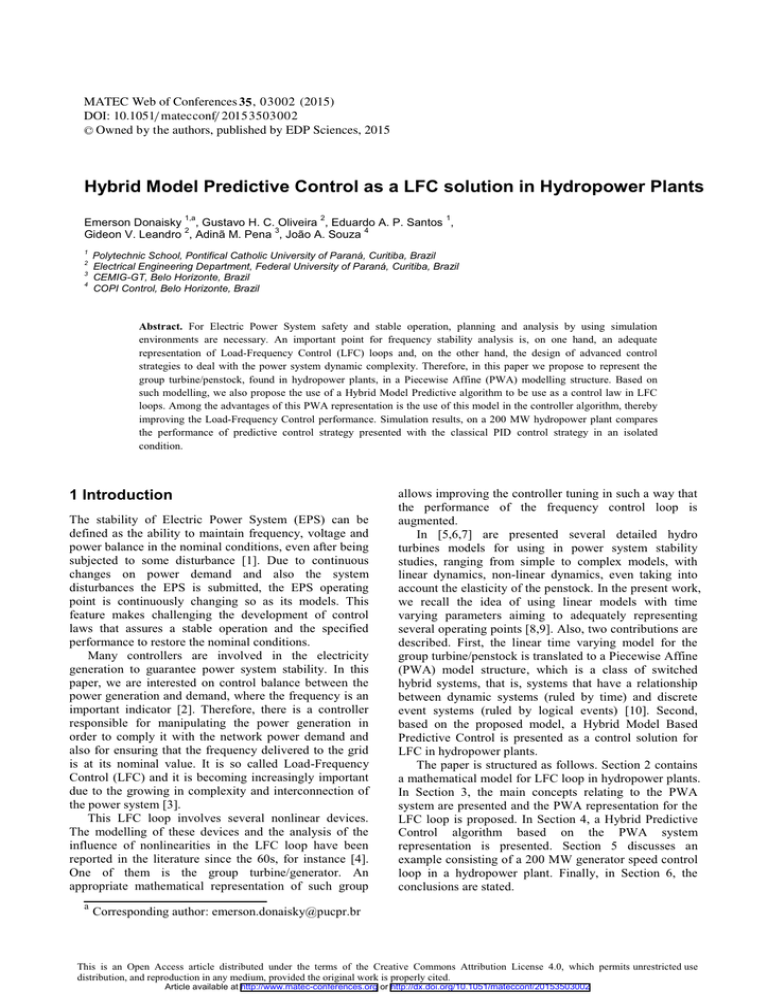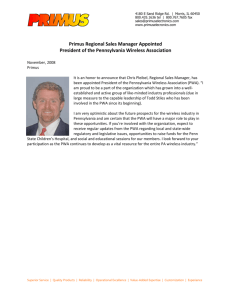Hybrid Model Predictive Control as a LFC solution in Hydropower...
advertisement

MATEC Web of Conferences 35 , 0 3 0 0 2 (2015)
DOI: 10.1051/ m atec conf/ 201 5 3 5 0 3 0 0 2
C Owned by the authors, published by EDP Sciences, 2015
Hybrid Model Predictive Control as a LFC solution in Hydropower Plants
1,a
2
1
Emerson Donaisky , Gustavo H. C. Oliveira , Eduardo A. P. Santos ,
2
3
4
Gideon V. Leandro , Adinã M. Pena , João A. Souza
1
2
3
4
Polytechnic School, Pontifical Catholic University of Paraná, Curitiba, Brazil
Electrical Engineering Department, Federal University of Paraná, Curitiba, Brazil
CEMIG-GT, Belo Horizonte, Brazil
COPI Control, Belo Horizonte, Brazil
Abstract. For Electric Power System safety and stable operation, planning and analysis by using simulation
environments are necessary. An important point for frequency stability analysis is, on one hand, an adequate
representation of Load-Frequency Control (LFC) loops and, on the other hand, the design of advanced control
strategies to deal with the power system dynamic complexity. Therefore, in this paper we propose to represent the
group turbine/penstock, found in hydropower plants, in a Piecewise Affine (PWA) modelling structure. Based on
such modelling, we also propose the use of a Hybrid Model Predictive algorithm to be use as a control law in LFC
loops. Among the advantages of this PWA representation is the use of this model in the controller algorithm, thereby
improving the Load-Frequency Control performance. Simulation results, on a 200 MW hydropower plant compares
the performance of predictive control strategy presented with the classical PID control strategy in an isolated
condition.
1 Introduction
The stability of Electric Power System (EPS) can be
defined as the ability to maintain frequency, voltage and
power balance in the nominal conditions, even after being
subjected to some disturbance [1]. Due to continuous
changes on power demand and also the system
disturbances the EPS is submitted, the EPS operating
point is continuously changing so as its models. This
feature makes challenging the development of control
laws that assures a stable operation and the specified
performance to restore the nominal conditions.
Many controllers are involved in the electricity
generation to guarantee power system stability. In this
paper, we are interested on control balance between the
power generation and demand, where the frequency is an
important indicator [2]. Therefore, there is a controller
responsible for manipulating the power generation in
order to comply it with the network power demand and
also for ensuring that the frequency delivered to the grid
is at its nominal value. It is so called Load-Frequency
Control (LFC) and it is becoming increasingly important
due to the growing in complexity and interconnection of
the power system [3].
This LFC loop involves several nonlinear devices.
The modelling of these devices and the analysis of the
influence of nonlinearities in the LFC loop have been
reported in the literature since the 60s, for instance [4].
One of them is the group turbine/generator. An
appropriate mathematical representation of such group
a
allows improving the controller tuning in such a way that
the performance of the frequency control loop is
augmented.
In [5,6,7] are presented several detailed hydro
turbines models for using in power system stability
studies, ranging from simple to complex models, with
linear dynamics, non-linear dynamics, even taking into
account the elasticity of the penstock. In the present work,
we recall the idea of using linear models with time
varying parameters aiming to adequately representing
several operating points [8,9]. Also, two contributions are
described. First, the linear time varying model for the
group turbine/penstock is translated to a Piecewise Affine
(PWA) model structure, which is a class of switched
hybrid systems, that is, systems that have a relationship
between dynamic systems (ruled by time) and discrete
event systems (ruled by logical events) [10]. Second,
based on the proposed model, a Hybrid Model Based
Predictive Control is presented as a control solution for
LFC in hydropower plants.
The paper is structured as follows. Section 2 contains
a mathematical model for LFC loop in hydropower plants.
In Section 3, the main concepts relating to the PWA
system are presented and the PWA representation for the
LFC loop is proposed. In Section 4, a Hybrid Predictive
Control algorithm based on the PWA system
representation is presented. Section 5 discusses an
example consisting of a 200 MW generator speed control
loop in a hydropower plant. Finally, in Section 6, the
conclusions are stated.
Corresponding author: emerson.donaisky@pucpr.br
This is an Open Access article distributed under the terms of the Creative Commons Attribution License 4.0, which permits XQUHVWULFWHGXVH
distribution, and reproduction in any medium, provided the original work is properly cited.
Article available at http://www.matec-conferences.org or http://dx.doi.org/10.1051/matecconf/20153503002
MATEC Web of Conferences
2 Load-Frequency Control Mathematical
Models
The mathematical model for LFC in Hydropower Plants
is depicted in Fig. 1 [7]. It consists of the control law, the
hydraulic amplifier, responsible for transforming the
electrical control signal into a power signal capable to
move the turbine components, the group turbine/penstock
and the synchronous machine, which generates electricity.
Such representation is consistent with single area control,
that is, a power plant operating in island condition.
Frequency
setpoint
() = + ( + ) +
( − ! + " ) + + ( −
! ) + ( − ! + " ) + ( − ! ) (3b)
#() =
Control
System
+
Hydraulic
Amplifier
Load
disturbance
Generatorr
The hydraulic amplifier is considered here a second
order system with time constant , according to Eq. 1.
The generator is represented by a first order system with
mechanical starting time and machine electrical
damping coefficient , according to Eq. 2 [11].
() = (
() =
$%&()
'*$()
-. -/0
,() +
. (. (-/1 /0 /2 /3 )/0 )/0 (-/1 )
() (3c)
3 Model Representation as a PWA
System
Figure 1. Block diagram of the LFC loop in a HPP.
Continuous linear dynamical systems are usually
represented by transfer functions. Moreover, some
systems have dynamic given by events and not by the
time. Such systems are called discrete event systems.
Hybrid systems are defined when there is a relationship
between continuous dynamical systems and discrete
event systems. Among the hybrid systems, we can find
the Piecewise Affine (PWA) systems [10]. In PWA
systems, there are regions defined by operating points,
and for each region, there is associated a linear system (or
affine). It is specified by dividing the system state space
into polyhedral regions and associating to each of these
regions a different linear (or affine) state equation. Eq. 4
gives this representation.
(1)
)
8(9 + 1) = <> 8(9) + ?> (9) + @>
456 = 7 A(9) = B> 8(9) + > (9) + C>
for [8(9) (9)] E Ω>
(2)
Fig. 2 reproduces, in a block diagram, the linear
model described in [12] for representing the group
turbine/penstock. Here, we are assuming that each
parameter of such model varies on time depending on the
active power generated by the power plant.
From
hydraulic
amplifier
() = ( − ) + +
( + − − ) +
(3a)
( + )
Governor
Turbine/
Penstock
Frequency
deviation
generator frequency output Y(s) can be rewritten as
follows:
To
generator
Frequency
deviation
Figure 2. Block diagram of the group turbine/penstock.
The final model for the LFC loop components, from
the hydraulic amplifier output U(s) , load disturbance
D(s) representing the electrical power demand, to the
(4)
where 8 is the state vector, is the input vector, A is the
output and {H> }&
>I are the polyhedral regions of the
state space defined by the system inequalities
{> [8(9) (9) 1] ≼ 0}. <> , ?> , @> , B> , > , C> and >
are real constant matrices with appropriate dimensions
and 9 is the discrete time. Although the notation may be
unusual, in this equation the symbol ≼ denotes a vector
of which the elements can be the symbols ≤ and < to
avoid overlap among the regions H> over common
boundaries.
3.1 PWA Model for the LFC Loop Components
We propose to rewrite the LFC model in terms of PWA
model in such a way that only one model can characterize
the whole turbine/penstock model behaviour in several
operating points. We define a grid of power generation
values, consistent with different power system operation
values. Each part of the grid is associated with a linear
model with constant parameters and regions in the state
space defined by > . The set of all grids defines the LFC
PWA model following Eq. 4.
03002-p.2
ICMCE 2015
The continuous time PWA model for the group
turbine/penstock and generator, derived from Eq. 3, is
given by Eq. 5, where 8(N) is the state vector, (N) is the
vector of inputs (hydraulic amplifier output and load
disturbance) and A(N) is the generator frequency output.
O
<
?
S
S
8̇ (N) = Q 5R
V 8(N) + Q 5R
V (N)
S
<T
S
?T
A(N) = [B5R BT ]8(N)
45R
0
< 5R = Z 0
≡X
\
B5R
4T ≡ O
0 1
0
V , ?T = a b ,
\ \
1
BT = [` ` ]
<T = Q
\ =
/0 (/1 -)
c . (/1 --/0 /2 /3 )- (. -c /0 )
c . \ =
\ =
/0 (/1 -)
/0 (/d / /e )
(5i)
c . c /d /0 .(/d / /e -/f /0 /2 -/ /g /0 /2 )
` =
/d -/f /0 /2
` =
` =
-/0
. -.
. (5f)
(5h)
. c . (5e)
(5g)
. . (/1 --/0 /2 /3 )- /0
` =
4h6 ≡ 7
?5R Bh6
S
S
S ^ 8 + Z?h6
<h6
S
S
<T
S
[B
]8
BT
A = 5R
<h6 = Q
w
x
t(9) = ∑yI
m(r)‖An(9 + r|9) − o(9 + r)‖ +
wz -
∑yI~
p(r)‖Δ(9 + r|9)‖
min%(
|
),⋯,%(
wz-|
) t(9)
subject to:
Δ(9 + r|9) = 0
∀r = k% , ⋯ , kl
0 ≤ (9 + r − 1) ≤ 1
∀r = 1, ⋯ , k%
An(9|9) = 456 ((9), > ) ∀ = 1, ⋯ , (5k)
(5l)
(5m)
S
S ^
(6a)
?T
0
1
0
V , ?h6 = a b ,
− - −2 -
1 (6b)
Bh6 = [ - 0]
The discrete time model for the LFC loop can be
obtained assuming a sample time ∆N and using some
methodology for the state space discretization [13]. For
each part of the grid, the matrix parameters from the
model are changed, originating the PWA model,
structured as Eq. 4.
(7)
The control law is obtained by minimizing the cost
function in relation to future variations in control signal
Δ(∙) according to Eq. 8. The process is subject to
constraints on control signal, according to Eq. 8. Since
output predictions are obtained by means of a PWA
model, we have the so called Hybrid Model Predictive
Control (HMPC) [14]. Such control law is defined by the
following nonlinear programming problem, with
nonlinear constraints, where > are the parameters for the
PWA model.
(5j)
The final model for the LFC loop components, from
the control output and load disturbance, to the generator
frequency output can be written in continuous time PWA
structure as follows:
< 5R
8̇ = Z S
X
S
Model Based Predictive Control (MBPC) is defined by
the following steps: i) a model is used to compute the
process output predictions; ii) a cost function related to
the performance of the closed-loop system is defined; iii)
this cost function is minimized over the future control
signals set; iv) the first of these optimal control signals is
applied to the process, i.e., the rolling horizon strategy.
The coast function of MBPC is given by Eq. 7, where
kl and k% define the prediction and control horizons,
respectively; m is a weighting factor in the prediction
error between the output signal An and the set-point signal
o ; p is a weighting factor in the control signal; and
Δ(9 + r|9) is the control variation signal in time 9 + r
calculated at time 9.
(5d)
c . c . \ =
(5b)
(5c)
c /0 (/1 -). (/1 --/0 /2 /3 )- /0
\ =
` =
1 0
0
0 1 ^ , ?5R = Z0^ ,
\ \
1
= [` ` ` ]
(5a)
4 Hybrid Model Predictive Control for
PWA Systems
(8)
The optimal set of future control signals can be
obtained using a mixed integer programming algorithm
or optimization algorithms and the optimal control signal
is calculated as follows:
(9) = (9 − 1) + Δ(9|9)
(9)
5 Simulation Results
To illustrate the operation of the proposed LFC loop
representation as a PWA system, in this work is used a
hydraulic turbine with 200 MW capacity, equivalent to
two generating units at the HPP Mactaquac Generating
Station of the New Brunswick Electric Power
Commission [8,12]. The turbine parameters for three
distinct operating points (denominated T1, T2 and T3, as
presented in [8]) are provided in Table 1. The other LFC
loop time unvarying parameters are given in Table 2. It is
considered that the HPP was operating in islanded
condition, that is, disconected from the EPS and
supplying the load demand alone.
03002-p.3
MATEC Web of Conferences
Table 1. Turbine/Penstock coefficients.
T1 = 22.5
MW
0.80
0.0
0.00
0.88
0.06
0.00
0.4
0.13
-0.39
T2 = 84.3
MW
0.40
2.3
0.30
0.90
0.20
0.50
1.2
0.38
-0.86
T3 = 113
MW
0.38
1.0
0.69
0.34
0.24
0.52
1.5
0.62
-0.75
0.6
Load (pu)
Operating
Point (pu)
"
!
0.4
0.2
0
0
2
4
6
Time (min)
8
10
Figure 3. Step load disturbances.
Table 2. Hydraulic amplifier, Turbine/Penstock and Generator
parameters.
85
(seconds)
(seconds)
(seconds)
(seconds)
3.5
2.35
0.15
10.25
0.8
= Q
S×"
S×"
= [S×"
1
−0.1125]
(10a)
−1 0.1125
V
1 −0.4215
(10b)
−1
(10c)
0.4215]
/
+ ' (11)
The test consisted basically of applying step load
disturbances, which represent severe disturbances in HPP,
as shown in Fig. 3. The result of the comparison between
these two control strategies is shown in Figs. 4 and 5.
Frequency (Hz)
70
65
60
50
0
2
4
6
Time (min)
8
10
Figure 4. Frequency for PID and HMPC controllers.
HMPC
PID
0.8
0.7
It has been compared two control strategies, that are: i)
the PID control strategy, where the Control System of Fig.
1 is replaced by Eq. 11, with parameters = 1.43 ,
> = 0.21 and ' = 0.54; and the proposed predictive
control strategy, with parameters kl = 50 , k% = 1 ,
m = 1 and p = 0. The PID tuning was made for the worst
operating point, and good response for the others
operating points, and the HMPC tuning uses prediction
horizon covering all system dynamics.
B() = +
75
55
Control Signal (pu)
Using the sampling time ∆N = 1.0 seconds, this
system, represented as a PWA structure, has = 3
polyhedral regions, representing the three operating
points, which are equivalent to loads (per unit) of
0 < T1 < 0.1125 ,
0.1125 ≤ T2 ≤ 0.4215
and
0.4215 < T3 < 1, and this points are used to construct
the coefficients of matrix > , as follows:
= [S×"
HMPC
PID
80
0.6
0.5
0.4
0.3
0.2
0.1
0
0
2
4
6
Time (min)
8
10
Figure 5. Control signal for PID and HMPC controllers.
As can be seen in Figs. 4 and 5, it is noted that both
control strategies present a large excursion of the
frequency in the machine output. This fact is caused by
large load disturbances applied to the HPP, that must
satisfy the demand alone. However, it is observed that the
HMPC was able to restore the frequency at its nominal
value in a shorter time.
03002-p.4
ICMCE 2015
6 Conclusion
4.
In this work, a new proposal for LFC law for
Hydropower Plants is described. The aim is to improve
frequency power system stability and closed loop
performance in restoring the nominal conditions. Two
points characterize the ideas discussed here. First, it is to
relate the linear time varying parameter turbine/penstock
model with a PWA model, which is a class of Hybrid
System. Second, based on this model, a new Hybrid
Model Predictive Control is described. Simulations
results, on a 200 MW hydropower plant model, operating
in isolated condition, is conducted and, compared with
classic PID control strategy, have shown an improved
performance.
5.
References
1.
2.
3.
6.
7.
8.
9.
10.
11.
P. Kundur, J. Paserba, V. Ajjarapu, G. Andersson, A.
Bose, C. Canizares, N. Hatziargyriou, D. Hill, A.
Stankovic, C. Taylor, T. Van Cutsem, V. Vittal,
IEEE Transactions on Power Systems 19, 1387-1401
(2004)
H. Bevrani, Robust power system frequency control 2,
391 (2014)
S.K. Pandey, S.R. Mohanty, N. Kishor, Renewable
and Sustainable Energy Reviews 25, 318-334 (2013)
12.
13.
14.
03002-p.5
H.E. Lokay, R.L. Bolger, IEEE Transactions on
Power Apparatus and Systems 84, 933-942 (1965)
I.C. Report, IEEE Transactions on Power Apparatus
and Systems PAS-92, 1904-1915 (1973)
W.G. Report, IEEE Transactions on Power Systems
7, 167-179 (1992)
N. Kishor, R.P. Saini, S.P. Singh, Renewable and
Sustainable Energy Reviews 11, 776-796 (2007)
K. Natarajan, IEEE Transactions on Energy
Conversion 20, 661-667 (2005)
A. Izena, H. Kihara, T. Shimojo, K. Hirayama, N.
Furukawa, T. Kageyama, T. Goto, C. Okamura,
IEEE Power Engineering Society General Meeting, 7
(2006)
W.P.M.H. Heemels, D. Lehmann, J. Lunze, B. De
Schutter, Handbook of Hybrid Systems Control:
Theory, Tools, Applications 1, 3-30 (2009)
P. Kundur, N.J. Balu, M.G. Lauby, Power system
stability and control 1, 1200 (1994)
D.T. Phi, E.J. Bourque, D.H. Thorne, E.F. Hill, IEEE
Transactions on Power Apparatus and Systems PAS100, 3203-3212 (1981)
K.J. Astrom, B. Wittenmark, Computer-Controlled
Systems: Theory and Design 3, 555 (1996)
E.F. Camacho, D.R. Ramirez, D. Limon, D. Muñoz
de la Peña, T. Alamo, Annual Reviews in Control 34,
21-31 (2010)




